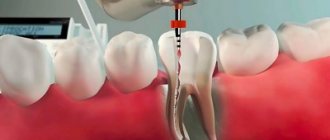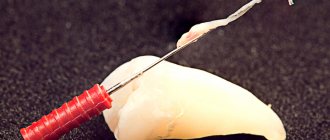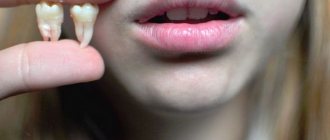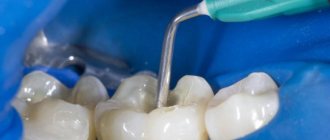When, after a visual and instrumental examination, inflammation of the pulp (tissue filling the cavity of the dental element) is detected in the patient, dentists perform tooth depulpation. A few decades ago, tooth depulpation was extremely painful, but today it is performed under local (or complete) anesthesia.
Pulp is a fibrous substance penetrated by a large number of blood vessels and nerve endings. If, as a result of pathological processes in the oral cavity, inflammation of the soft tissues of the tooth occurs, then such a procedure is the only way to stop tooth decay and prevent the need for its extraction. Although some clinics today offer dental treatment “in your sleep,” that is, under general anesthesia, most dentists perform depulpation under local anesthesia. There are two methods of treatment: vital and devital.
Important: when depulping, the dentist is guided by x-rays before and after the procedure, since it is necessary to ensure the tightness of the canals.
What is depulpation and what is its essence?
What does tooth depulpation mean? Let's break the word down into parts - “de” means “removal”, and “pulp” refers to the soft neurovascular bundle that is located inside the tooth cavity and in the root canals. That is, depulpation or depulpation is the removal of the so-called “dental nerve”. After which the “empty” areas are filled with filling mass or pins, and then closed with crowns, inlays or special fasteners for dentures. Depulpation[1] is irreversible, i.e. a new pulp does not form in place of the removed one. Dental tissues cease to receive nutrition from the inside, and the tooth itself is considered “dead.” But this does not mean at all that it will fall out soon.
Any dentist should be able to carry out this procedure, but in the field of work this is most often done by dental therapists or more specialized specialists - endodontists. That is, if a patient comes to an orthopedist for a prosthesis, then if pulp removal is necessary, he will refer the person to a dentist-therapist.
Indications for nerve removal
Once the nerve is removed, the tooth becomes dead and brittle. Therefore, depulpation is not done immediately; instead, therapeutic treatment is prescribed. However, there are situations when this procedure must be done. It is recommended to remove the nerve in the tooth:
- when there is pulpitis (severe inflammatory process in the pulp);
- when there is periodontitis;
- in case of deep caries, if it has affected the pulp;
- in case the tooth has been injured.
What is the purpose of depulpation?
The goal of the procedure is to achieve several important results that will allow the patient to wear the prosthesis for a long time. Moreover, during the entire period of wearing the person will not be bothered by pain and the need to remove, for example, a crown. Let's take a closer look at what effect should be achieved:
- the pulp will not overheat during grinding of the stump and, accordingly, will not become inflamed (i.e., pulpitis will not appear under the crown),
- cariogenic bacteria will not penetrate into the pulp (i.e., pulpitis is again excluded),
- It will be possible to place pins or a core inlay into the canals: this will strengthen the restoration, i.e. it will last longer.
Don't know what type of prosthetics to choose?
We will help in the selection, advise where to read more information and compare types of prosthetics.
Consultation with an orthopedic doctor in Moscow clinics is free! Call now or request a call
Working hours: from 9:00 to 21:00 - seven days a week
Stages of implementation
The procedure to completely remove the nerve will require two visits to the dentist. During the first visit, the doctor will perform the following manipulations:
- Local anesthesia of the area where treatment will be performed.
- Preparation of dental tissues to open access to the pulp chamber.
- Pulp removal.
- Closing the cavity with a temporary filling.
At the second visit, the dentist removes the temporary filling, antiseptically treats the root canals and installs permanent filling material in them. Next, the dental crown is restored. If after removal of the pulp the patient experiences pain, it is necessary to postpone prosthetics until the pain has completely passed. Sometimes the doctor installs temporary (so-called diagnostic) crowns, which the patient wears for several weeks, determining how comfortable he is with the dentures and whether there are any complications after removing the nerves. Therefore, when the dentist suggests installing a temporary crown first, it is better not to refuse.
When a nerve must be removed - indications
Whether tooth depulpation is necessary before prosthetics or not, only a doctor can say after a thorough examination - instrumental and x-ray. Mandatory removal of the dental nerve is necessary for the following indications:
- there are signs of pulpitis, i.e. inflammatory process of the pulp: pain, darkening of the deep layers of dentin,
- the top of the tooth is severely damaged,
- the natural crown has massive fillings,
- the patient often experiences relapses of caries,
- it is planned to install a crown with thick walls (for example, metal-ceramic): in this case, it is necessary to sharpen the stump quite strongly, which will lead to thinning of the dentinal layer (i.e., the pulp underneath will be less protected) and to its potential overheating during treatment with a drill. As a result, if depulpation is not performed, the risk of pulpitis increases and the time for re-prosthetics approaches.
When nerve removal is indispensable
In modern dental practice, both complete and partial resection are used. Indications for the procedure:
- deep carious tissue damage;
- chronic pulpitis (including asymptomatic);
- bactericidal infection spread by the apex of the tooth root;
- the presence of an extensive pulp area, the threat of developing periodontitis or transition to periodontitis;
- trauma leading to nerve exposure and tooth destruction;
- the need to correct a medical error;
- the need for prosthetics with low crowns.
Unbearable pain can also be an indication for depulpation.
The dentist will never prescribe such a serious intervention as long as it is possible to save the tooth.
Important : problematic “eights” when affected by caries, as a rule, are removed. This is due to the location of the “wisdom” teeth at the end of the dentition, which makes cleaning them from plaque and stone and filling the canals very problematic. Indications for removal are also the wrong direction of eruption, displacement of the dentition, malocclusion, and the development of pulpitis.
When can you do without deletion?
Let's consider situations when depulpation can be abandoned, i.e. do not perform it before prosthetics:
- the stump (ground tooth tip) has thick walls,
- the pulp is not inflamed,
- in the future there is no risk of caries/pulpitis under the denture,
- overheating of dentin and pulp is excluded.
For veneers and restorative inlays, you can, in principle, do without depulpation altogether, as well as for thin ceramic crowns - but only if all the requirements just outlined are met.
Contraindications to the procedure
Contraindication is children's age. Or rather, a milk bite - here it is forbidden to go through root canals with instruments, because... the developing rudiments of permanent teeth can be damaged. Intolerance or prohibition of the administration of anesthesia is also a contraindication. As well as serious mental disorders, when a person can unknowingly harm himself during dental procedures.
Read on the topic: indications and contraindications for installing dentures.
How is the procedure performed?
How is tooth depulpation done? It is carried out in at least 2 visits to the clinic. In one visit, removing the pulp and immediately placing a filling or pin can be dangerous because if pathological areas remain in the cavities, then over time inflammation will develop under the prosthesis. Next, we will consider how depulpation occurs and what stages are included in it.
First visit to the doctor
First of all, the patient is given an x-ray to find out the condition of the pulp and the presence of inflammation under the roots. Then they give a “freezing” injection with an anesthetic. To remove the pulp, the dentist needs to drill out part of the hard tissues - enamel and dentin. First, the pulp is removed from the pulp chamber. And then, using special endodontic instruments, you will need to remove all the loose pulp from the canals. After this, medicine is put inside and a temporary filling is placed, which lasts for an average of 7-14 days. During the process, you need to take an x-ray to assess the quality of the work. And in the most modern clinics, canals are treated under a microscope.
If the pulp is removed using arsenic paste, the treatment technology is different. Anesthesia is not required here, because... it does not hurt. Paste is placed into the cavity and closed with a filling. After 2-3 days, the patient must return to the clinic, because... It is during this time that arsenic will “kill” the pulp bundle and may begin to negatively affect healthy tissue. If the filling falls out or is damaged, you should immediately contact the clinic.
Second visit to the dentist
At the second appointment with the doctor, the medicine or arsenic paste is removed, the canals are processed, dried and sealed. Next, you again need to take an x-ray to assess the quality of the filling and the absence of “empty” areas. The patient is sent to an orthopedist, where the doctor will unseal the canal a little and place a pin, stump tab or attachment (lock) for a removable denture into it, and then take impressions for a crown or other orthopedic structure.
What is vital depulpation?
Vital pulpotomy is the amputation of an inflamed nerve under the influence of anesthetic substances. Treatment is carried out in one visit to the dentist. It consists of the following stages:
- anesthesia;
- removal of tooth enamel and dentin with a drill;
- antiseptic treatment of the mouth;
- removal of tissue (fibrous substance, neurovascular bundle) from the pulp cavity and canals;
- filling channels with a composite composition;
- closing the tooth cavity with restoration materials.
The appearance of pain and its causes
Why does a tooth hurt after pulp removal? Soreness often occurs after the anesthetic injection wears off. Pain after the procedure occurs for several reasons - normal and pathological. Here you need to understand the nature of the pain and what it is talking about.
For example, if the pain is tolerable or can be easily eliminated with painkillers, if it weakens every day, then this is a variant of the norm. After all, during the passage and expansion of the channels, healthy tissues were slightly injured, and pain is a natural reaction of the body. How long can a tooth without a nerve hurt after the procedure? On average, the discomfort goes away completely in 7-14 days. But in some patients it persists for 4-6 weeks and then disappears.
Read on the topic: what to do if a tooth hurts under a crown - causes of pain and methods for eliminating it.
The pathology is considered to be severe pain for several days, which is practically not relieved by pills. And also the reappearance of pain a few days or weeks after a period of painlessness. Symptoms such as severe redness and swelling of the gums, fever, headache, and bad breath should alert you. These signs most likely indicate that the depulpation was carried out incorrectly and inflammation began under the prosthesis. Or aggressive caries develops under the crown. Dental care is needed here, otherwise complications may arise - periodontitis, for example.
Do no harm
A patient consulted a doctor with one missing tooth and nearby intact teeth with a high crown.
Upon completion of prosthetics, the patient received a metal-ceramic prosthesis and two pulpless, heavily ground teeth. Such cases come across often. There is another way, the right way - do not depulpate the supporting teeth unnecessarily. This path is more complex, requiring more accuracy, caution, additional materials and a more respectful attitude towards the patient and his teeth. Often patients have the question “Why is it necessary to remove nerves from healthy teeth before prosthetics?” To tell the truth, this is not a mandatory procedure at all. When a patient comes without any complaints and is offered to turn “living” teeth into “dead” ones, deliberately changing their status from “healthy” to “previously treated”, this cannot but cause bewilderment in the patient.
On the other hand, why should the patient pay for such work? And in general, how to justify the need for such “treatment”? What “diagnosis” should be made before performing endodontic treatment on a healthy tooth?
And where is the guarantee that dental treatment will be successful and the doctor will not have to accept claims in the near future? Even with an arsenal of modern endodontic instruments, materials, ultrasonic devices, and sufficient practical skills, it is not always possible to achieve the desired effect.
It is also known that teeth without nerves, called “dead”, become fragile, more susceptible to destructive processes of hard tissues, their shock-absorbing function changes, especially after the widely used resorcinol-formalin method, and this does not bode well for patients.
For dental prosthetics without depulpation, we provide an extended 3-fold guarantee.
How long will a tooth last with and without a nerve?
It all depends on the skill of the doctor, on how competently he assessed the future functionality of the tooth with or without the preserved nerve. If metabolic processes are maintained in the supporting unit (i.e., while the pulp is preserved), then its service life is expected to be longer than that of the pulpless one. When all the conditions on the part of the dentist are met, and the patient treats the restorations with care, then, if the nerve is preserved, the support under the prosthesis can last on average 8-10 years (under a single crown) and about 7 years under an extended structure. If a tooth is “dead,” then its service life is shorter by an average of 30%, i.e. about 5 years.
But if the prosthetics are performed poorly, if the patient does not take good care of the prostheses, then the nerve may become inflamed - and very soon treatment and a new orthopedic design will be required.
Is it necessary to depulpate all teeth for crowns?
One of the main questions is whether it is necessary to depulpate a tooth (remove the nerve) if it is planned for a crown? A huge number of patients, what about patients, even dentists are still convinced that teeth under a crown must be depulped!
This is wrong! YOU DO NOT NEED TO DEPULPATE YOUR TEETH UNDER CROWNS! Moreover, it is criminal. A living tooth is much more physiological than a dead one, it will live longer and can endure more than one crown change. In addition, if the tooth was killed without proper indications, the patient can also sue for moderate mutilation. Sometimes there are indications for this (incorrect position of the tooth, as a rule), but they are few.
A dead tooth is always a risk of complications after canal filling and an organ weakened by fillings. To remove the pulp, most of the enamel and dentin are removed, leaving a large filling in the middle with thin walls of the tooth on the sides, which the doctor will also remove when processing it for a crown. So what remains? Not much.
Even according to the best statistics, pulpless teeth survive on average from five to fifteen years. And if the doctor fails to properly fill the canals and find all the branches from them, then even less.
A living tooth is always better! However, there are clear conditions. In order for the tooth to survive the treatment, several rules must be followed. We will give only three main ones.
- Tooth processing must be carried out strictly with water cooling, otherwise you will inevitably get a burn to the pulp. The presence of a saliva ejector and a vacuum cleaner requires mandatory four-handed work with an assistant (otherwise there will simply be no one to hold these tools). Considering that in our country many district clinics still have six chairs per nurse in their office, normal treatment in this case is almost impossible.
- Tooth processing should be carried out only with new burs. Old “bald” burs do not so much process the tooth as overheat it and can also cause burns to the pulp. If the clinic saves on burs and gives the doctor two burs for six months, then you can forget about living teeth.
- Immediately after treatment, the doctor must make and place a temporary crown on the living tooth. Otherwise, the patient will experience extremely unpleasant sensations due to pain, and the dental pulp will be exposed to thermal and chemical effects from the oral cavity, which can lead to chronic pulpitis. If the doctor thinks that temporary crowns are a hussar and a waste of time, then you will not see a living tooth after treatment.
Apologists of the ancient theory that “the tooth under the crown must be depulped”, as a rule, have only one argument. What if then the living tooth under the crown hurts and all the work will have to be redone.
You don’t have to, not all of it! We won't talk about long bridges. This is yesterday. If you do not abuse them, but do it as it should be according to the rules for uniting teeth, then at most a diseased tooth will require alteration of one or two crowns, no more.
Pulpitis is usually detected in the first six months. Any non-removable orthopedic structure has a minimum one-year warranty. Rework is carried out under warranty. The patient pays only for endodontics, for which he would have paid anyway if he had followed the rule of pulp removal before prosthetics.
Therefore, the doctor who sends you for depulpation immediately is simply not confident in his work and does not want to redo the crown later at his own expense.
Statistics suggest that complications after treatment occur in less than 1% of cases.
Well, at the same time, consider what is more profitable for the patient? Should I take a risk within one percent and leave all my teeth alive, or be sure to destroy all the nerves in all my teeth so as not to risk it? At the same time, knowing for sure that pulpless teeth, according to statistics, live several times less!
That is why we urge both doctors and patients not to depulpate teeth before prosthetics.
And there is no charity or self-interest in this. Only science, high-quality work and accurate calculations.
Does the shade of dental tissue change after the procedure?
Does the tooth darken after depulpation? Yes, over time the color will change - it will become gray and lifeless, because the tissues do not receive nutrition from the inside. But the pulpless unit is covered with a prosthesis - so the change in shade will be completely invisible from the outside. If the color of the prosthesis itself has changed, then the reason for this may be the following:
- the use of low-quality materials for manufacturing or non-compliance with its technology,
- staining from coffee, wine, food coloring, tobacco,
- formation of plaque and stone due to poor oral hygiene.
What to do?
If you feel pain in your tooth, you should immediately go to the dentist. He will determine the reason for its appearance. If the body reacts to filling in this way, then anti-inflammatory drug therapy is usually prescribed. It promotes faster recovery. If the cause of the pain is poor-quality filling, then treatment will take longer.
Previously, if there was pain in a pulpless tooth, they said to remove it. Thanks to modern methods of treating pulpitis, it is possible to unfill the canals and cure them. Other surgical and therapeutic methods may also be used. Therefore, it is important to seek help in time.
What complications may arise
During the process of removing the dental nerve, the following complications may occur:
- perforation of the root wall,
- exit of the instrument or filling mass beyond the root: as a result, periodontitis begins - root inflammation,
- fracture of the instrument in the root canal: such fragments are very difficult to remove, sometimes the entire tooth has to be removed.
Many dentists perform pulp removal only to insure against possible complications after prosthetics - caries or periodontitis. After all, then you will have to remove the prosthesis, treat the tooth, and then make a new prosthesis, because the old one either cannot be removed without damage, or it will not fit on a fresh filling or stump inlay. But let us repeat once again, they will not remove the nerve without clear indications.
Complications
The most common complications after nerve removal before replacement are pain and swelling. Normally, these symptoms go away within a day at most. If the pain does not go away, intensifies, or swelling does not subside, you need to consult a doctor. He will conduct diagnostics to identify the causes. It could be:
- Poor quality channel cleaning
. An incorrectly chosen length of the tool does not allow you to go through the canal to the end. Remains of pulp cause inflammation - residual pulpitis. - Root canal perforation
. Through the destroyed apex, the infection penetrates into the periodontium (tissue around the tooth), causing pain. - Missing tooth canals
. All canals are not always visible on the image, and this is the only source of information for the dentist. The remaining pulp becomes inflamed, causing discomfort. - Tooth fracture
. If the anatomical shape of a tooth is not restored immediately, it may break. - Violation of sealing technology
. This may be incorrect proportions for mixing the composition or the filling material getting on soft tissues.
Sometimes, after endodontic treatment, the tooth darkens. Without pulp, no food is supplied to the tooth, and cells are not renewed. Dentin dries out and its color darkens. Another reason is that the enamel becomes porous and pigments penetrate through it more easily. Sometimes, the tooth darkens due to hemorrhage when the nerve is removed before prosthetics.
Don't be afraid, it's not dangerous. The denture will provide a protective barrier and hide discoloration.
Features of care after removal
Oral care after dental nerve removal and prosthetics must be regular and thorough. Twice a day you need to use a brush and paste, follow the correct cleaning technique (only sweeping movements). It is recommended to rinse your mouth after each meal, and also to exclude toffees, chewing gum, hard pieces of food, and not to chew nut shells or seeds. In order to promptly identify and eliminate dental problems, you should visit an orthopedic dentist at least 1-2 times a year.
“I had a crown placed on a post about 7 years ago. They did it very well and treated it under a microscope. But after the prosthetics, the dentist told me not to forget to come to them every year or every six months for an examination. At the same time, professional hygiene was carried out. I’ve never had any problems in all this time, I eat whatever I want.”
Anna, review from irecommend.ru
Pain in a pulpless tooth
Pain in a tooth from which the nerve has been pulled out is more normal than an accident. But there may be good reasons for this:
- the cleaning and filling of the canals was not done well enough;
- not the entire nerve was removed;
- the filling material is not of high quality;
- gums become inflamed as a result of injury, etc.
These reasons can be traced only after the completion of the standard healing period (the characteristics of the body are taken into account). After problems are discovered, the doctor must find the cause and eliminate it. In order to monitor the quality of the work done, it is worth taking an x-ray.
Advantages and disadvantages of depulpation
The advantages of tooth depulpation are that it will eliminate or almost completely minimize the risks of pathologies appearing under the prosthesis - it all depends on the skill of the dentist and the patient’s attitude towards the new smile. The disadvantage is that the tooth will become “dead”, i.e. more fragile and with a shorter service life than non-pulpless. But these shortcomings are eliminated, again, by high-quality treatment and materials, and competent care of restorations, as well as the absence of extremely high chewing loads.
What is the procedure for devital tooth depulpation?
After the dentist is sure that the anesthesia has worked, the procedure itself is carried out:
- the specialist opens access to the pulp cavity using a drill;
- a special substance is placed into the cavity, which will lead to the death of the nerve;
- the cavity with the medicine is closed with a temporary filling;
- when you return to the dentist’s office, the pulp is removed along with the neurovascular bundle, the doctor cleans the tooth cavity of dead tissue, and performs instrumental and medicinal treatment of the canals;
- after the doctor is convinced that the source of inflammation has been completely eliminated, the canals are sealed;
- The dental crown is restored using filling composite materials.
Interestingly, dentists used to often immediately close a pulpless tooth with a permanent filling, that is, they performed a vital pulpotomy. Today the practice has changed. In almost all cases, a temporary filling is first installed, allowing the specialist to assess the effectiveness of treatment and the stage of healing.
After depulpation, a tooth reaction to hot food may be observed as a result of mechanical intervention. Unpleasant sensations may persist for up to two weeks. To alleviate the patient’s condition, a specialist may prescribe special medications for this period to relieve pain.
Important: if after two weeks the painful symptoms have not disappeared, a repeat x-ray is taken, since prolonged symptoms may be an indicator of a relapse.
How much does depulpation cost?
How much does tooth removal cost? The cost of the procedure ranges from 3000-4000 rubles per 1 tooth in small cities, and in large cities, when treated under a microscope, from 3000-4000 rubles per 1 root canal (there can be 3-4 of them in one tooth). It is more profitable if the clinic offers turnkey installation of the prosthesis - absolutely all manipulations, examinations and materials are included in the total price.
[1] Shashmurina V.R. Biomechanical features of dental depulpation, 2022.
Author: Dulgarov Zh. G. (Thank you for your help in writing the article and the information provided)
Pulp is the general name for the “internal organs” of a tooth. To understand what root canal treatment is, why it is needed, and what the criteria are, let’s look at the structure of the tooth.
A tooth has two main parts: the crown and the root. Inside each tooth there are cavities that are filled with loose fibrous connective tissue - pulp. In the past, root canal treatment was called “removing the nerve.” But the nerve is only one of the components of the pulp.
tooth structure
A tooth is a whole living organ. Through the apex of the tooth root – the apex – a bundle of blood and lymphatic vessels and nerve endings enter the tooth. When, due to advanced caries or as a result of injury, the enamel and dentin of a tooth are damaged, the infection penetrates inside, into the pulp, and inflammation of the internal tissues of the tooth occurs - pulpitis.
Depulpation or treatment of pulpitis includes two main points: cleaning and filling . This is significantly different from installing a regular filling. During cleaning, the doctor removes all the inflamed pulp from the coronal part and all the root pulp. In order to do this efficiently, there are modern diagnostic methods, including computed tomography (CT) and work with a microscope. They allow you to accurately assess the number of root canals, their location, shape and degree of destruction.
depulpation
Until some point, it was believed that the upper sixth teeth had three roots, but now in 80% of cases there is an additional fourth root canal. The lower incisors have one canal, but additional branches can often be seen on a CT scan or under a dental microscope. Previously, they went unnoticed, which means they were infected. The infection spread, complicated inflammation occurred, and the tooth was destroyed. Modern dental techniques, such as the use of CT scans and microscopes, give doctors more opportunities for accurate diagnosis.
The first important criterion in the treatment of pulpitis is maximum cleaning of the canals. They need to be passed all the way to the apex, to the very apex, where the neurovascular bundle enters the tooth. This is done mechanically using special tools, so-called files. After this, the root canal is expanded, removing all the inflamed pulp, and a taper is created so that it can be properly filled with filling material.
Channels are often curved, have micro-branches, and their mechanical processing is limited. On the first visit, after mechanical cleaning, a preparation is left in the tooth, which chemically sterilizes the branches of the canals that are inaccessible for mechanical treatment. After a while, the canals are filled and the tooth crown is restored.
We always try to keep teeth alive so that they perform their functions well. A pulpless tooth is a dead organ. It is like a prosthesis that is neither capable of regeneration nor of perceiving too cold or hot to protect itself. But there are situations when, due to caries or injury, the pulp is damaged, becomes inflamed, and that very familiar toothache occurs, which, due to a natural change in the blood supply to the body, intensifies by night. Previously, arsenic was applied under a temporary gluten filling, and then the nerve was mechanically removed. For such manipulations, dentists are feared at the genetic level. But today in modern clinics, treatment of any pulpitis is accompanied by anesthesia, and patients do not experience any pain.
What are the criteria for treating teeth with pulpitis? They often think that it is enough that the tooth does not hurt and there is a filling. But even if the tooth hurts for 3-4 days or a week without treatment, the pulp dies. Due to infection, the nerve, blood vessels and tooth become dead. But if the pain goes away, this does not mean that the tooth has recovered! It becomes a hidden source of infection, and the next stage may develop when the infection progresses further. The tooth is secured in its bed by a system of ligaments. The space between it and the jaw is filled with connective tissue - periodontium. If the pulp in the tooth has already died, it will become a source of infection, which passes into the periodontium and then we get periodontitis - inflammation of the root tips and tissues around the tooth. In this case, the body tries to localize the source of inflammation, and a cyst may appear (from the Greek κύστις “bubble”). This is a cavity that fills with exudate (pus), and from which bone destruction can begin.
In a living tooth, a possible reaction to cold/hot due to enamel defects quickly passes because the tooth is restored. But if the pulp is inflamed, then under the influence of chemical and mechanical irritants it will hurt for a long time. Depending on the stage of inflammation, the duration of pain increases. As soon as the inflammatory process moves to the periodontium, we begin to feel pain when biting. This happens because the ligaments on which the tooth is suspended in its socket normally absorb pressure. But if the tooth is sick, then the inflamed receptors perceive any pressure as an excessive load and signal about it.
The immune system can hold back the development of such hidden inflammatory processes for some time, but as soon as the immune system is weakened, due to banal hypothermia, the amount of exudate can begin to increase sharply, and then we see gumboil and facial asymmetry. This is already inflammation of the periosteum. There is also a milder course of periodontitis, when a fistulous opening is formed on the gum, and during exacerbation, pus comes out of it. In patients, it happens that something swells, then goes away, an abscess appears and goes away. The presence of a fistula may be an indication that there is a problem with the roots of the teeth.
It is important for patients to know that even high-quality root canal treatment involves depulping the tooth. The tooth becomes dead, and this has much more difficulties than treating caries.
Timely diagnosis, prevention and treatment will save you from complex root canal treatment. But if it has come to this, it is important to understand that this is a responsible operation. It is not quick, it is not cheap, but it is necessary. Root canal treatment can take a long time – two to three visits. This depends on the number, shape of the root canals and the degree of infection.











